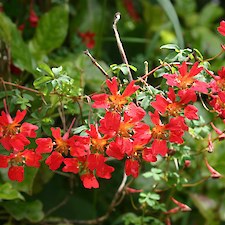 Chilean flame creeper
Chilean flame creeper
Common name: Chilean flame creeper
Botanical name: Tropaeolum speciosum
Management programme: Exclusion
As the name suggests, this plant is native to Chile. It was brought into the country as a garden ornamental plant and was confirmed as naturalised by 1958.
Why is it a pest?
- Chilean flame creeper invades forest margins and disturbed sites, climbing high into tree canopies, suppressing growth, and replacing native species by shading and smothering them.
- It tolerates warm to cold temperatures, damp to dry conditions, salt, wind and many soil types.
- Seed dispersed by birds or by root fragments.
Where is it found?
- Chilean flame creeper is not known to be in the Bay of Plenty.
- Disturbed forest and shrubland, possibly gardens as the flowers are quite attractive.
What does it look like?
- Chilean flame creeper is a climbing plant with coiling tendrils and long leaves which die off over winter.
- Slender stems and blue-green five fingered leaves approximately 10-35mm long.
- Tubular scarlet flowers with five irregular petals in summer (November to April), the bottom three having a very slim claw.
- Flowering is followed by thin fleshy, deep blue berries in autumn.
What are the rules?
Exclusion
Chilean flame creeper is an exclusion pest. This means that it is not yet established in the Bay of Plenty region. Bay of Plenty Regional Council is responsible for managing any new incursions into the region.
How do you get rid of it?
Chilean flame creeper is extremely hard to control. Let us know if you think you have seen this plant or have it on your property by emailing stop.pests@boprc.govt.nz or alternatively call 0800 884 880.
Images








